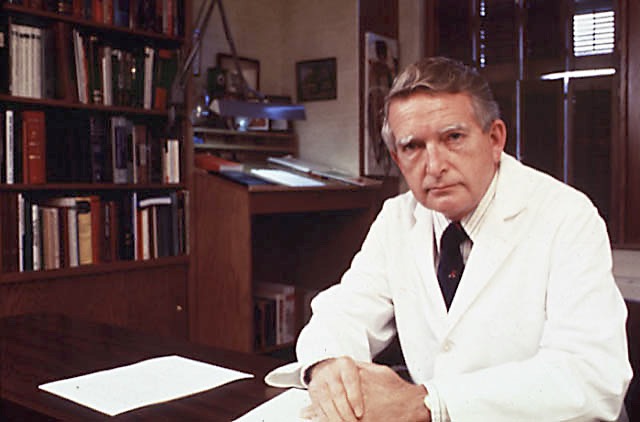Main navigation
Researched and Written by
Dr. Fred Stamler
The College of Medicine and University Hospitals recognized the need for considerable expansion of the pathology staff and activities and made the institutional decision that this department should assume and carry out the major responsibilities for diagnostic laboratory services to this medical center. On the strength of this commitment and the opportunities and challenges that it presented for the development of a superior department, a new chairman was recruited and the long, slow process of rebuilding the department was begun. This new chairman was George Dial Penick, a graduate of Harvard Medical School and a colleague of Kenneth Brinkhous at the University of North Carolina.

As frequently occurs with a change in department headship and a redirection of policies, considerable turnover in personnel took place. Key people were recruited into subspecialty areas where strong clinical programs required appropriate laboratory backing, especially in the field popularly termed "clinical pathology." And yet, in so doing, a special effort was made to keep the department a unified one in order to bring a total approach to our laboratory services and teaching programs. The decision was made to incorporate the laboratories at the Veterans Administration Hospital into the department in order to avoid unnecessary and costly duplication of laboratory facilities and equipment and to coordinate with the successfully consolidated programs in some of the clinical departments. Through negotiation of a contract with the Veterans Administration and rotation of our staff through the VA Hospital, this was accomplished.
In 1969, the department was housed in areas that were widely separated throughout the Medical Laboratories Building, University Hospitals and Oakdale Hospital. At that time, the Medical Chemistry and Hematology Laboratories, the Blood Bank and some faculty occupied space in University Hospitals; the Medical Technology Teaching Laboratories, Special Chemistry and faculty utilized 3,820 square feet at Oakdale Hospital. The remainder of the department functions, including faculty and house staff offices, administrative office, research laboratories and teaching programs were housed in 15,298 square feet of space on the basement and first floors of the Medical Laboratories Building.
Certain improvements were made in the physical plant that facilitated consolidation of the department and improvement in laboratory efficiency, basically the Basic Science Building was built, releasing space to Pathology. New administrative offices were constructed that enabled the Department Head and Vice-Chairman to coordinate their efforts and to have the immediate support of personnel concerned with fiscal matters, personnel, supplies, and equipment, and general administration. New laboratories were designed and built to house medical chemistry, hematology, immunopathology and histopathology. An effective word-processing center was developed to handle centrally the large demands for typing involved in rendering pathology reports, preparation of teaching materials, manuscript typing and general correspondence.
Extensive effort was invested in revamping the teaching programs. This involved enthusiastic effort on the part of the faculty under the guidance of Dr. Thomas Kent, acting in the capacity of Departmental Course Director. The main thrusts of the changes adopted in our courses for medical students was to create self-paced courses through the development and introduction of much new self-instructional material, to make the student laboratory experience more meaningful by adopting a case study approach, to expand the material taught to reintroduce clinical pathology into the curriculum, and to utilize the computer for course monitoring and student performance evaluation. A graduate program leading to the granting of an MS in Pathology was created. The department also reassumed responsibility for instruction of the College of Dentistry students that had previously been carried out by the Department of Oral Pathology. It also provided courses for the Physician’s Assistant program and other paramedical personnel. There was a steady progressive expansion in the size of the house staff, from four in 1970 to 20 in 1980.
Very successful studies were carried out in conjunction with the Department of Medicine in relation to the transfusion of blood platelets under the support of an NIH contract. There was continued participation in the Specialty Center of Research in Atherosclerosis and thrombosis of particular interest to Dr. Penick.